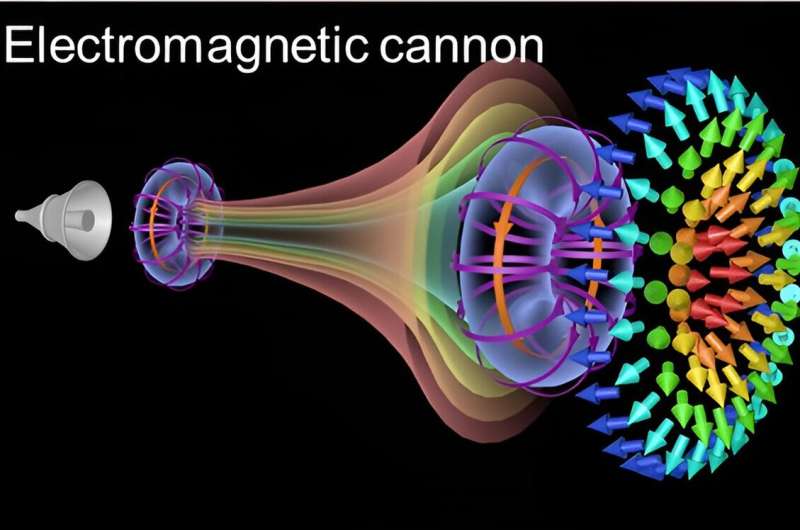This article has been reviewed according to Science X's editorial process and policies. Editors have highlighted the following attributes while ensuring the content's credibility:
fact-checked
peer-reviewed publication
trusted source
proofread
Electromagnetic vortex cannon could enhance communication systems

Vortex rings, a mysterious and fascinating natural phenomenon, display breathtaking structures and behaviors in both air and electromagnetic waves. Imagine an air cannon that can shoot vortex rings, creating a perfect air vortex that travels gracefully through the air as if an invisible hand is sketching an elegant curve in the sky. This vortex phenomenon is not just a spectacle of physics but a masterpiece of nature.
The creation of air vortices is a captivating blend of science and aesthetics. When an air cannon fires, the instantaneous pressure difference causes the air to form a rotating ring structure that propagates steadily through the air, showcasing the unique shape and dynamics of the vortex. Applying the same principle to electromagnetic waves, we can envision an "electromagnetic vortex cannon" that directly emits electromagnetic vortex rings. Thanks to the dedicated efforts of researchers, this concept is gradually becoming a reality.
Recently, Associate Professor Ren Wang from the University of Electronic Science and Technology of China, Assistant Professor Yijie Shen from Nanyang Technological University in Singapore, and their collaborators from the University of Southampton in the UK proposed a method using coaxial horn antennas to directly emit electromagnetic vortices. They observed the resilient propagation characteristics and skyrmion topological structures of these vortices.
Their work, titled "Observation of Resilient Propagation and Free-Space Skyrmions in Toroidal Electromagnetic Pulses," has been published as a Featured Article in Applied Physics Reviews.
These scientists summarize the operational principle of their electromagnetic cannon, saying, "The principle involves utilizing ultra-wideband, radially polarized, conical coaxial horn antennas to create a rotating electromagnetic wave structure. When the antenna emits, it generates an instantaneous pressure difference that forms these vortex rings, which maintain their shape and energy over long distances. The uniqueness of this method lies in its ability to produce electromagnetic pulses with complex topological features, such as skyrmions, that showcase remarkable resilience and self-healing properties during propagation."
"The potential applications of this technology are vast and exciting. In high-capacity communication systems, these vortex pulses could revolutionize how we transmit information by offering efficient and robust methods of data encoding. The unique spectral and polarization characteristics of the vortex rings allow them to carry more information compared to traditional waves, making them ideal candidates for next-generation communication networks.
"Furthermore, their ability to maintain structural integrity even in the presence of environmental disturbances positions them as valuable tools in remote sensing and target detection. By analyzing the unique patterns of these vortex pulses, we can develop more precise and reliable methods for detecting and locating objects, whether in defense systems or space exploration," the scientists say.
"As we reflect on the implications of our findings, [we're] particularly excited about how this research could lead to groundbreaking advancements in metrology and information processing. The spatiotemporal inseparability of the vortex pulses provides a foundation for developing new techniques in complex data encoding and high-precision measurements. Additionally, the skyrmion textures embedded within the vortex rings offer intriguing possibilities for topological data storage and processing, potentially leading to more efficient ways of managing and analyzing large datasets.
"This work not only demonstrates the incredible versatility of electromagnetic vortex rings but also sets the stage for future innovations in wireless technology, creating opportunities to redefine our understanding of electromagnetic phenomena," the scientists add.
More information: Ren Wang et al, Observation of resilient propagation and free-space skyrmions in toroidal electromagnetic pulses, Applied Physics Reviews (2024). DOI: 10.1063/5.0218207
Journal information: Applied Physics Reviews
Provided by Chinese Academy of Sciences




















